Our choice of the best 24-70 mm lenses.
A 24-70 lens is usually referred to as a “walk-around lens.” It’s frequently used by photographers for all sorts of photoshoots.
The best 24-70 lenses are wide-angle models that are a great choice for mastering the art of photography. The broad view is ideal for landscape, city, and event pictures. Such lenses are available with various depths of field, allowing you to easily focus on both close and distant subjects without any problems.
The range of 24-70 mm usually covers all the most popular and handy focal lengths, from wide-angle to the standard 35/50 mm settings and up to the 70 mm telephoto range.
A 24-70 2.8 lens can be used with both full-frame and cropped cameras, with the latter demanding a sacrifice at the wide-angle range, but offering an improved telephoto setting, which is great if you plan to take many portraits.
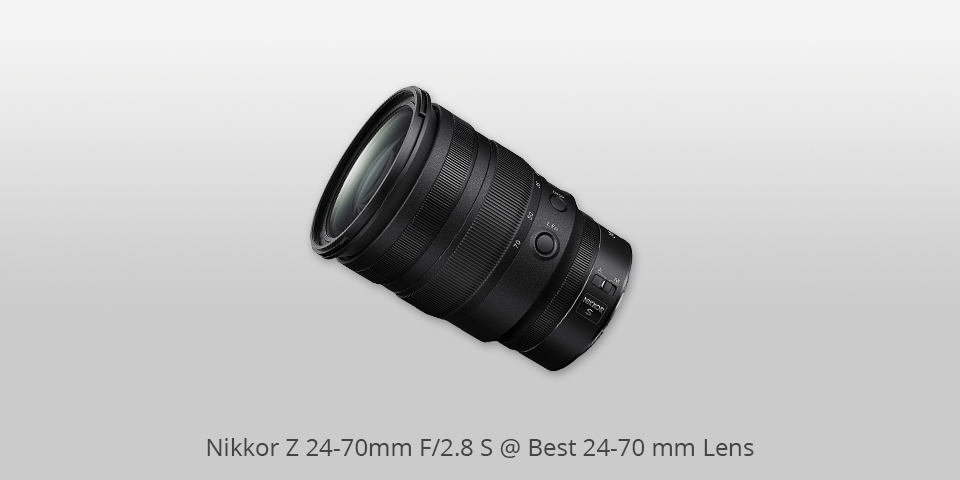
Mount: Nikon Z | Diaphragm blades: 9 | Autofocus: Yes | Min focus distance: 0.38 m | Max magnification: 0.22x | Filter thread: 82 mm | Dimensions (WxL): 89x126 mm | Weight: 805 g
⊕ Good multi-focusing
⊕ Impressive mid-range zoom
⊕ Terrific anti-reflective properties
⊕ Configurable control button
⊕ Dust and drip protection
⊖ High control ring sensitivity
⊖ Costs quite a lot
The most useful feature that makes this Nikkor product one of the best 24-70 lenses around is the increased maximum aperture. This makes it a great choice for portrait photographers who prefer to use a shallow depth of field to create a smooth, defocused backdrop.
The lens has a configurable L-Fn button that can be set to perform up to 21 various actions, including AF lock, metering, bracketing, etc.
The Nikkor Z 24-70mm utilizes a fantastic multi-focusing mechanism that relies on a pair of autofocus drive units, which are perfectly synchronized to provide quick and precise autofocusing.
The lens also has weather-resistant properties thanks to the fluorine coating that makes cleaning it a breeze.
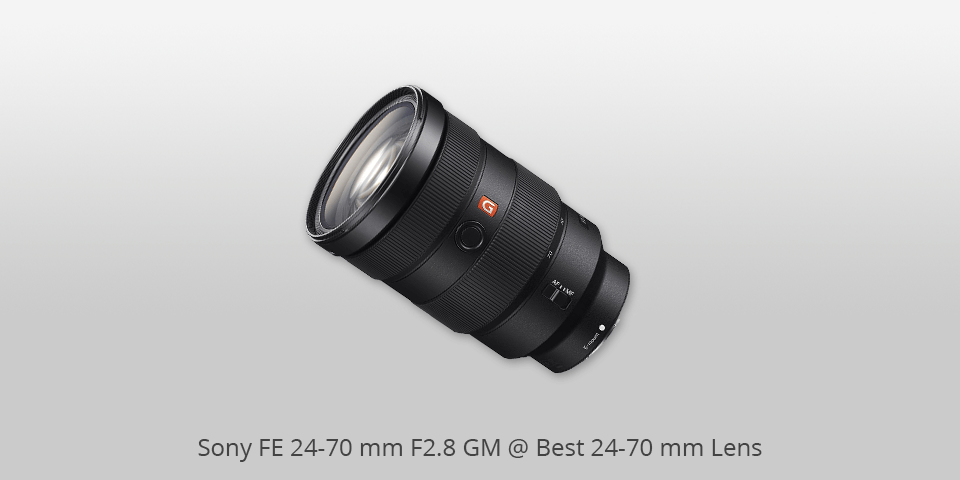
Mount: Sony E | Diaphragm blades: 9 | Autofocus: Yes | Min focus distance: 0.38 m | Max magnification: 0.24x | Filter thread: 82 mm | Dimensions (WxL): 87.6x136 mm | Weight: 886 g
⊕ Build quality
⊕ Terrific picture quality
⊕ Superb resolution and bokeh
⊕ Accurate quick focus
⊕ Minimized aberration
⊖ Lacks image stabilization
⊖ Somewhat heavy and bulky
This Sony model just might be the sharpest 24-70 lens available right now, as its extreme aspherical element allows you to take highly-detailed photos with minimum distortion, ghosting, and aberrations.
The lens also has a quick and accurate AF that is supported by Sony’s Direct Drive SMM mechanism.
This product has dust and moisture sealing that makes it just as good for outdoor use as it is for indoor photoshoots.
The lens comes with a focus lock button, which can be customized to your needs, depending on which camera you’re using.

Mount: Nikon F | Diaphragm blades: 9 | Autofocus: Yes | Min focus distance: 0.38 m | Max magnification: 0.28x | Filter thread: 82 mm | Dimensions (WxL): 88x154.5 mm | Weight: 1070 g
⊕ Durable and well-designed construction
⊕ Image stabilization
⊕ Quick and quiet autofocus
⊕ Impressive optical characteristics
⊕ Beautiful bokeh
⊖ Visible distortion
⊖ Uneven illumination at f/2.8
The innovative features of this Nikon product make it easily one of the best 24-70 lenses on the market, capable of competing with the best 85 mm lens. It has the first-ever aspherical extra-low dispersion component that serves to provide previously unseen accuracy and performance.
The Silent Wave Motor autofocus offers great speed, while the image stabilization can compensate for up to 4 stops.
The lens is protected with Nano Crystal and super built-in coatings that improve the picture quality by minimizing flares, and enhancing contrast and colors, while the fluorine coating at the front and back of the lens offers superior protection against dust, water drops, and smudges.
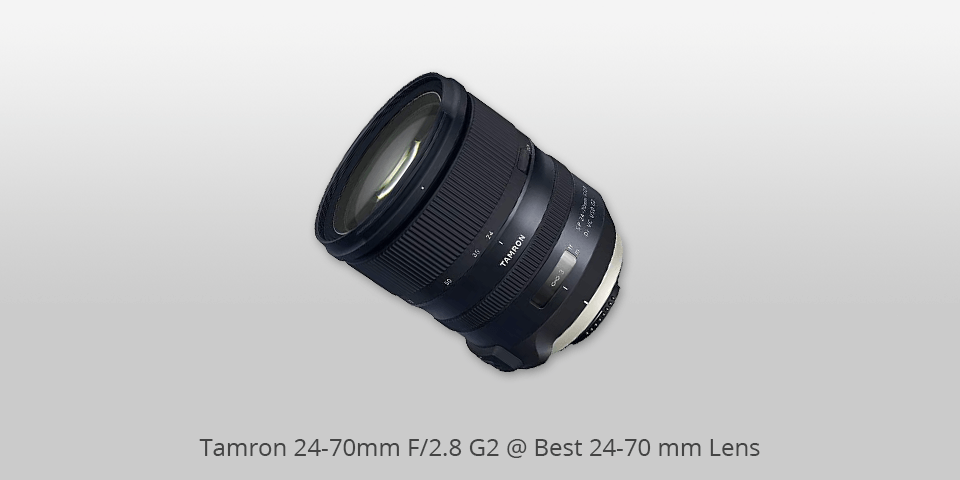
Mount: Canon, Nikon | Diaphragm blades: 9 | Autofocus: Yes | Min focus distance: 0.38 m | Max magnification: 0.2x | Filter thread: 82 mm | Dimensions (WxL): 88.4x111 mm | Weight: 905 g
⊕ Special micro-processor
⊕ Top-tier picture quality
⊕ Great anti-reflection characteristics
⊕ Moisture-resistant build
⊕ Minimum dispersion
⊖ Noticeable distortion
⊖ Corners are a bit dim
This 70 mm lens has a broad f/2.8 aperture, vibration compensation, and a moisture-resistant build supported by eBAND and fluorine coatings.
Several strengths make this option stand out from the rest including top-tier build quality, convenient controls, 5-stop image stabilization, and high bokeh sharpness.
The lens utilizes an ultrasonic Silent Drive motor, which is instrumental in providing a smooth, quick, and silent autofocus.
Finally, this product comes with a tiny lock switch that helps keep the barrel in place.
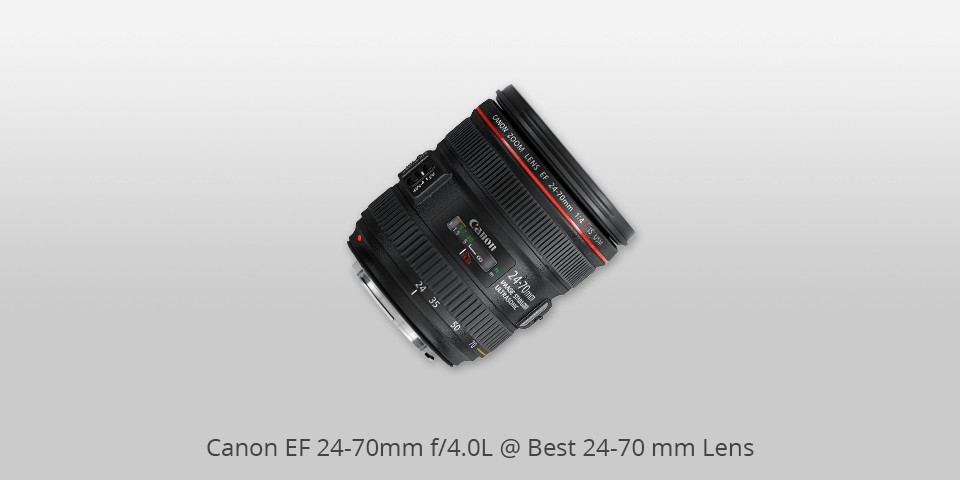
Mount: Canon EF | Diaphragm blades: 9 | Autofocus: Yes | Min focus distance: 0.38 m | Max magnification: 0.7x | Filter thread: 77 mm | Dimensions (WxL): 83.4x93 mm | Weight: 600 g
⊕ Flexible zoom range
⊕ Quick ultrasonic autofocus
⊕ Up to four-stop IS system
⊕ Dust and moisture-sealed design
⊕ Handy macro mode
⊖ Bokeh lacks smoothness
⊖ Some serious vignetting
This Canon product is among the best 24-70 lenses if you’re looking for a reliable, durable option. It has terrific dust- and splash-resistant properties as well as rubber sealing on the mount. The lens is also equipped with a ring-type ultrasonic motor that provides quick and quiet autofocusing.
The state-of-the-art macro feature makes this lens more versatile by letting you take photos with a max magnification value of 0.7x.
This Canon lens is supplied with a solid image stabilization system that can compensate for up to four f-stops without having to use a stabilizer. You can turn this system on and off by using the switch on the side of the lens.
Other important advantages of this option include reasonable pricing and a small, lightweight body.
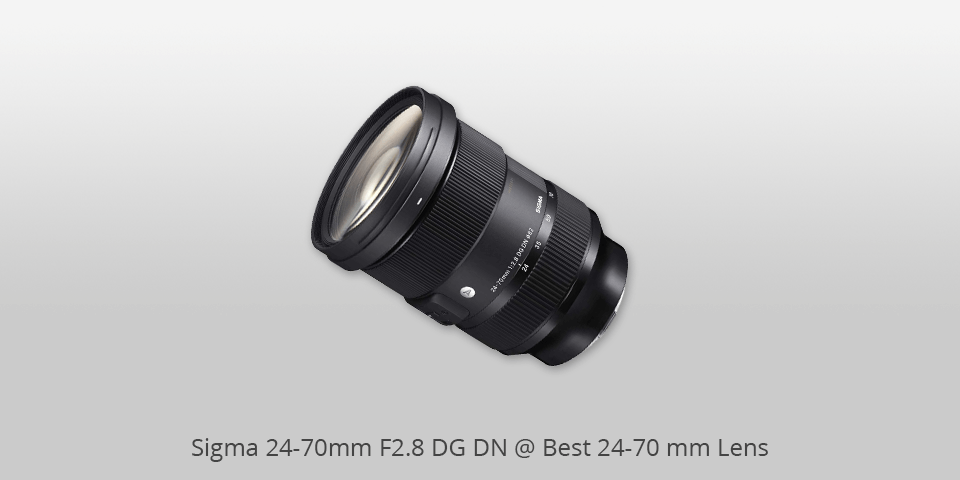
Mount: Sony E | Diaphragm blades: 11 | Autofocus: Yes | Min focus distance: 0.38 m | Max magnification: 0.34x | Filter thread: 82 mm | Dimensions (WxL): 87.8x124.9mm | Weight: 830 g
⊕ Terrific performance
⊕ Satisfying picture quality
⊕ High-quality multi-layer coating
⊕ Dust and splash resistant design
⊖ Lacks image stabilization
⊖ A strange soft locking system
There are many reasons why this product is often featured among the best 24-70 lenses, including a rounded, 11-blade aperture that adds a nice blur to the parts of the shot that aren’t in focus.
Thanks to the implemented multilayer and Nano-porous coatings, the lens suffers from minimum flare and ghosting, while producing a color-neutral image with crisp colors, even with strong backlighting.
This Tamron lens relies on a stepping motor and an advanced algorithm to provide an Autofocus mechanism that offers good acceleration speed and minimum noise, which is exactly what you need for a relaxed focusing experience.
The built-in AF-L button can be customized to accommodate different shooting settings, and the lens has a special AF/MF switch and a zoom lock that ensures the barrel doesn’t extend by accident.
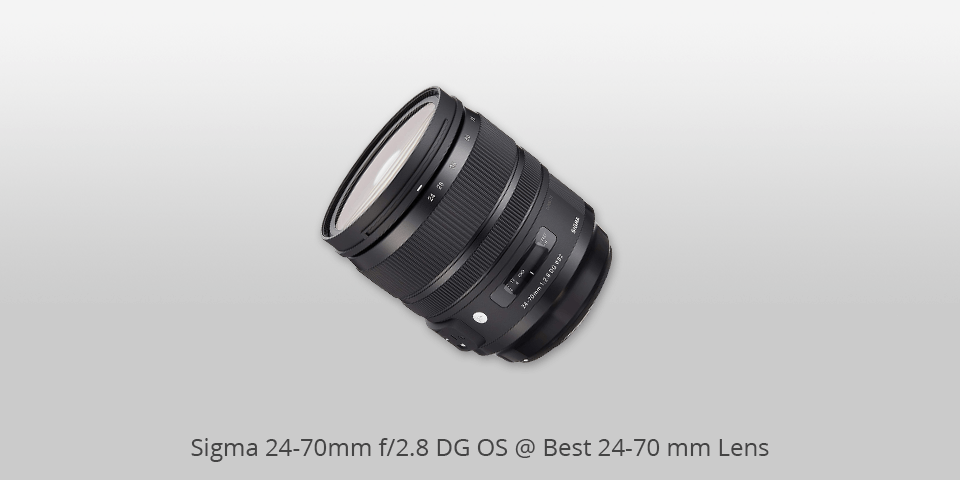
Mount: Sigma, Nikon F, Canon EF | Diaphragm blades: 9 | Autofocus: Yes | Min focus distance: 0.37 m | Max magnification: 0.21x | Filter thread: 82 mm | Dimensions (WxL): 88x107.6 mm | Weight: 1020 g
⊕ Small and durable build
⊕ Top-tier optical performance
⊕ Fast and quiet autofocus
⊕ Terrific picture quality
⊖ Rather bulky
⊖ No weather sealing
Suitable for both full-frame and cropped cameras, this cheap 24 70mm lens comes with 3 Special Low Dispersion (SLD) and 4 aspherical components as well as top-grade multilayer coating.
The autofocus mechanism is powered by the built-in Hyper Sonic Motor, which offers terrific speed in almost all lighting conditions.
This Sigma model also has optical image stabilization, with up to 4 compensation stops. It provides a solid bokeh and is perfectly suited for wide-angle photos.
The lens is equipped with a brass bayonet mount, which ensures prolonged durability.
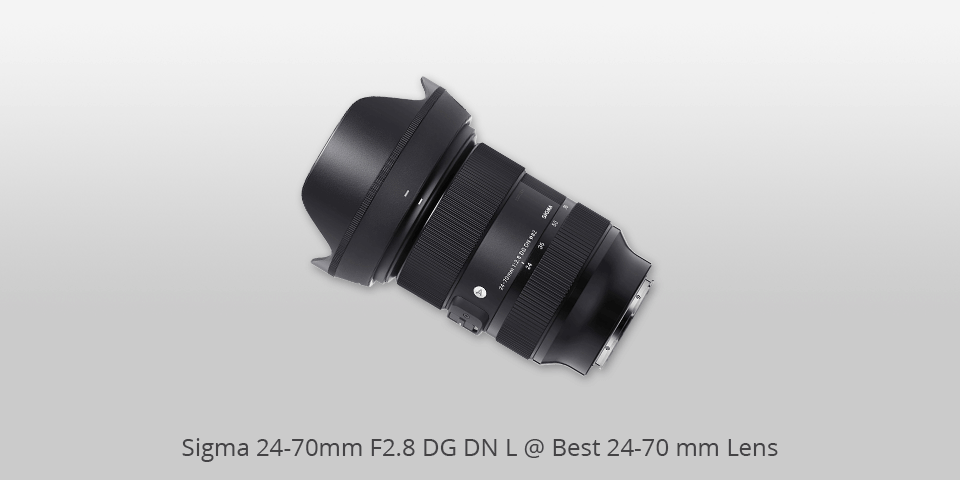
Mount: L-mount | Diaphragm blades: 11 | Autofocus: Yes | Min focus distance: 0.38 m | Max magnification: 0.34x | Filter thread: 82 mm | Dimensions (WxL): 87.8x122.9mm | Weight: 835 g
⊕ Unparalleled optical performance
⊕ AFL button
⊕ Nanoporous coating
⊕ Hood with lock
⊖ Noticeable distortion
⊖ Lacks image stabilization
This Sigma lens is designed for an L-Mount and has a built-in stepping motor that ensures the AF system works quickly and silently, with its performance being further improved thanks to the state-of-the-art autofocus algorithm.
The high-quality multilayer coating is paired with NPC coating, with both of them serving to make the lens less vulnerable to overwhelming incident lighting (like backlighting).
The focusing lock is paired with a Manual/Auto-focus switch and a zoom lock. The lens also comes with a brass bayonet mount, which offers superior durability. Meanwhile, the optics are made of top-grade glass.
The overall design quality of the lens is nothing short of impressive and the weather sealing works great as well.
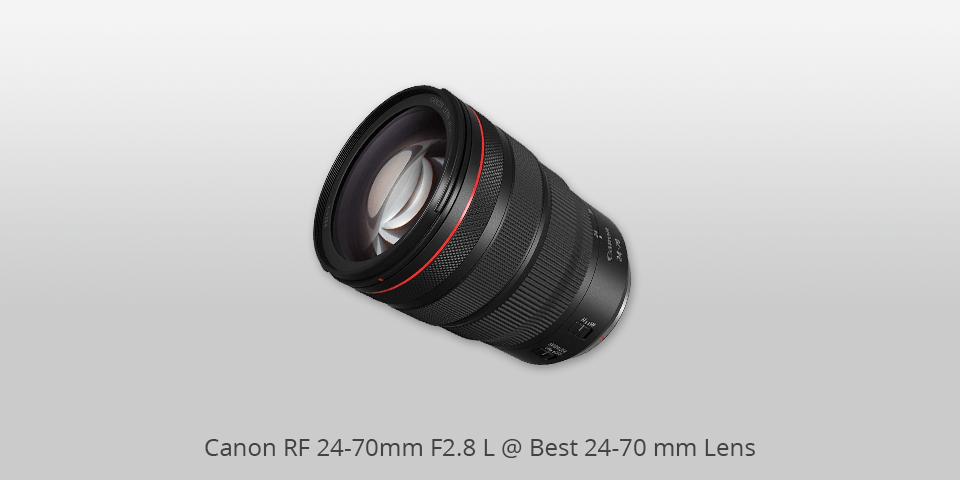
Mount: Canon RF | Diaphragm blades: 9 | Autofocus: Yes | Min focus distance: 0.38 m | Max magnification: 0.3x | Filter thread: 82 mm | Dimensions (WxL): 88.5x125.7 mm | Weight: 900 g
⊕ State-of-the-art optical design
⊕ Nano USM motor
⊕ 5-stops image stabilization
⊕ Quick and silent autofocus
⊕ Dust and weather resistance
⊖ Mediocre edge sharpness
⊖ High price
This 24-70 2.8 lens comes with a Nano USM focus motor that can handle the big glass components of an RF lens with both high speed and accuracy. The built-in stabilizer compensates for up to 5 stops of camera shake, allowing you to enjoy highly-sharp images even in low-light conditions.
The control ring is built-into the lens and allows you to conveniently adjust the exposure with the lens.
The Canon RF 24-70mm provides top-tier build quality, has reliable weather-sealing and fluorine coatings on the front and back components to protect the lens from water and dust.
| Image | Name | Features | |
|---|---|---|---|
 |
Nikkor Z 24-70mm F/2.8 S
Our Choice |
CHECK PRICE → | |
 |
Sony FE 24-70 mm F2.8 GM
Full Frame |
CHECK PRICE → | |
 |
Nikon 24-70mm f/2.8E
for DSLR |
CHECK PRICE → |

Getting one of the best 24-70 lenses is a terrific decision if you want to grow as a photographer. That being said, picking the best option among them can be difficult if you don’t know which aspects you have to consider when making your choice.
Here are the aspects that you should keep in mind when purchasing a lens:
Firstly, look at the different lens manufacturers that occupy the market. When making your decision, you have to know that all brands have a proprietary lens mount and most companies don’t exactly cooperate with the rest.
All lenses have their own aperture range. The aperture also referred to as the f-stop figure, lets you determine how much of the scene is in focus. A smaller f-stop means a smaller area will be focused, while a larger setting like f/32 will have most of the shot in focus. If the lens can go as low as f/2.8, then you’ll only have a tiny area of the shot in focus, while the rest will be surrounded by a beautiful blur. That is exactly the type of blurry backdrop that you’ll see in a lot of professional portraits.
The larger the max possible aperture (aka the smaller the f-stop figure), the more freedom you have when employing the lens. A smaller f-stop can sustain quicker exposures in subpar lighting conditions, enabling you to take photos indoors without flash and capture high-quality images at dawn or dusk. It’s also suitable for taking pictures of dynamic subjects.
Stabilization isn’t a must-have feature if you’ll only use the camera for stills, as all you need to do to achieve a crisp, sharp picture is set a fast shutter speed. That said, situations when you’re shooting in low light conditions, using a long focal length, or recording footage, demand image stabilization. Thankfully, the majority of the best 24-70 lenses come with this feature.
You can recognize the availability of this feature by the following brand-specific tags:
Nikon – VR,
Canon – IS,
Sigma – OS,
Tamron – VC.
Companies like Olympus, Pentax, and Sony offer in-camera stabilization, so their lenses don’t offer this feature.
Some photography genres require a top-notch autofocus system, with the prime examples being street, sports, and wildlife photography. All 3 of these genres often have situations when it's crucial to capture one exact moment, which is impossible to do without instant autofocus. The higher your budget, the more robust the autofocus system you’ll be able to enjoy.
The majority of enthusiast-level lenses are produced with plastic housing and occasionally a plastic mount so that they can be offered at affordable prices. Meanwhile, products that are aimed at professionals have sturdier housing, which is heavier but will last you a lot longer than budget options. Additionally, professional-level lenses typically have weather sealing, which allows you to use the camera in extreme conditions.

Having a lens hood is crucial if you want to minimize flare. Most latest models have one, but there are some exceptions. If a specific 24-70 camera lens you plan to buy doesn’t include one, then factor in the extra money you’ll have to spend on a hood. The same approach also goes for tripod collars if you plan to get a bigger lens. Lens hoods also offer a layer of protection for the front element of the lens. The extended shape of the hood acts as a shield against accidental bumps, scratches, and fingerprints. This helps preserve the lens's overall condition and can potentially save photographers from costly repairs or replacements.
24-70mm describes the focal range of the lens. The smaller the figure (the first number), the more of the scene you’ll capture in the shot. The bigger the focal length (the larger figure), the narrower the picture will be. The values in a 24-70mm lens refer to its focal range. You can either set the lens to its broadest angle (24mm), most zoomed in range (70mm), or leave it anywhere between the two points.
Such a lens offers both flexibility and functionality, as its focal range is a terrific fit for most types of photoshoots. From broad landscapes to intimate portraits, you can always rely on a 24-70 mm lens to have your back.
It’s a good choice for portrait photographers, especially if you plan to take plenty of full-body and environmental shots. If your lens can sustain a max aperture of f/2.8 on the entire zoom range, you’ll be able to enjoy a terrific balance between low-light and zoom functionality.
This model is often used as a workhorse by a lot of both professional and enthusiast photographers that take it with them on all kinds of photoshoots to take pictures of everything from panoramic landscapes to close-up portraits.

 Rating
Rating